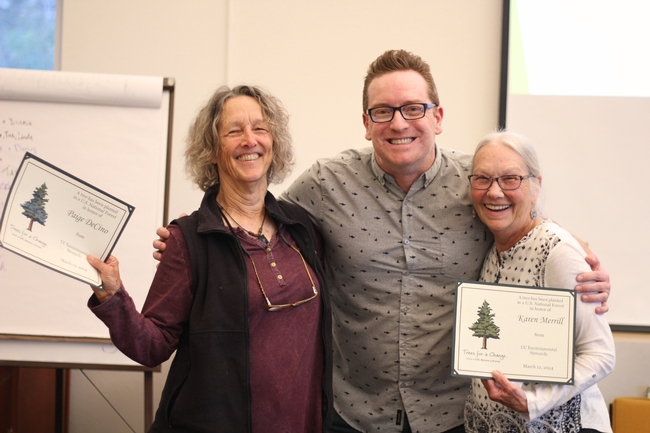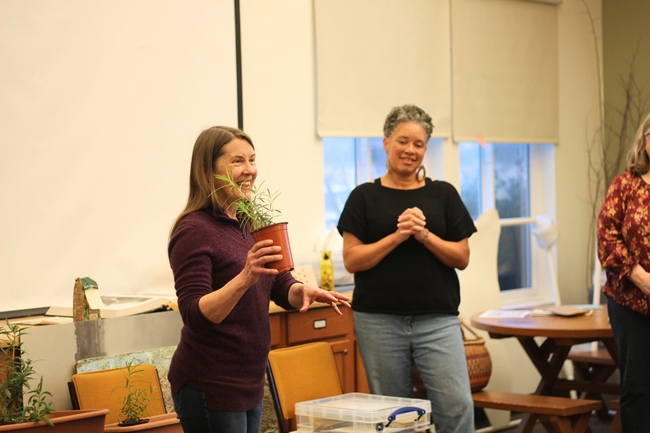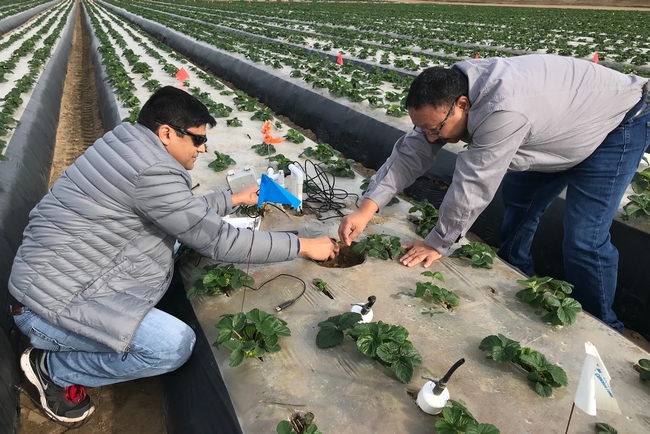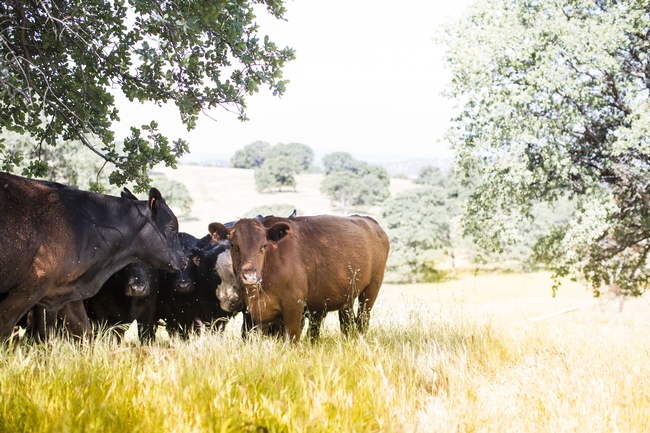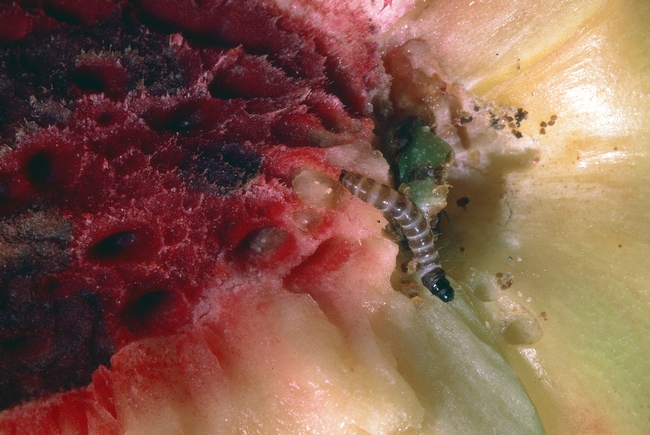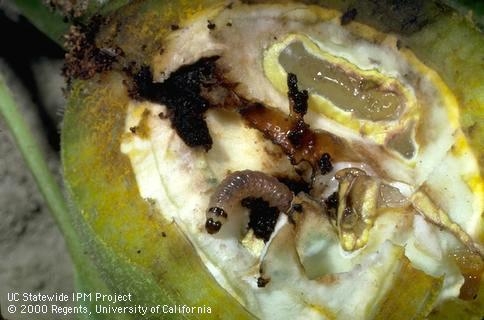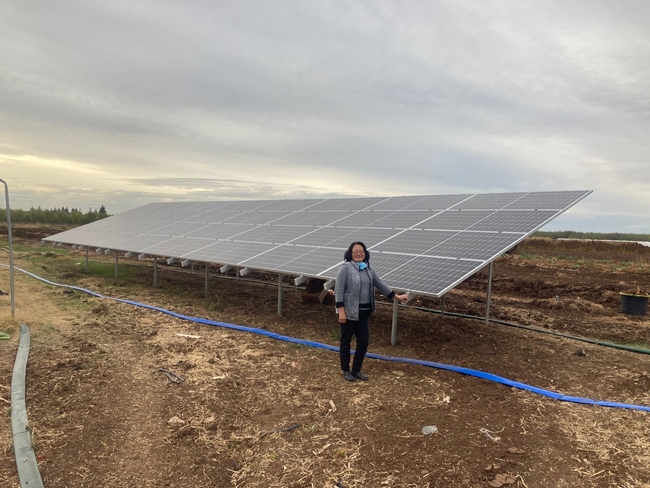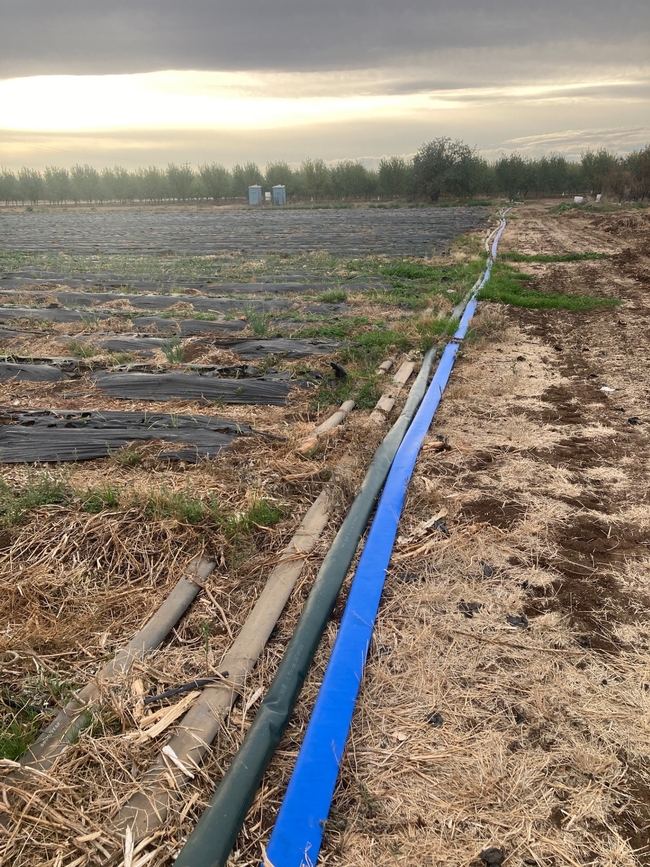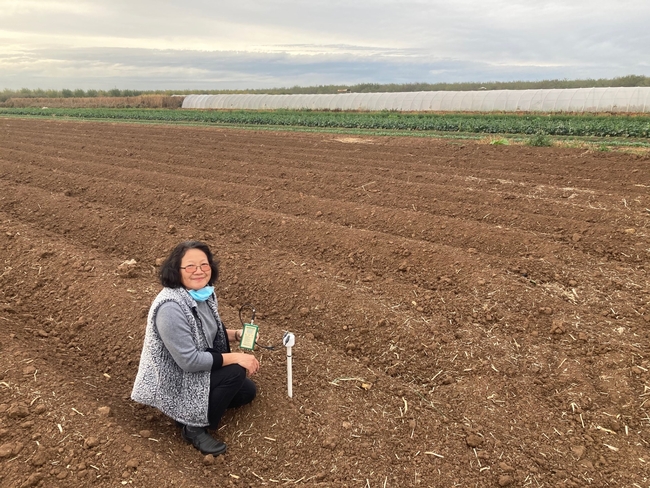Posts Tagged: climate
New UC California Naturalists inspire care for nature in San Diego County
Nearly 200 residents trained in past seven years by program, a part of UC Environmental Stewards
On one of her darkest days, Tammah Watts stood in front of her kitchen sink to fill a pitcher of water. Outside of her window, the San Marcos resident noticed a flutter in the distance. She spotted a small yellow bird emerge from the tree and her eyes grew in admiration.
Bird-watching from her kitchen window became an escape for Watts while she was temporarily homebound after a surgery. It's where she found connection beyond the interior space of her home.
“I started noticing other birds that had always been there. The yard didn't change, but my mind and my perspective did,” she said.
Eager to learn more and expose others to her new hobby and its healing power, Watts joined the University of California Environmental Stewards program, a statewide program housed under UC Agriculture and Natural Resources, to become a certified California Naturalist.
The program offers two environmental education certification courses: the California Naturalist course, which introduces people to the wonders of California's unique ecology and engages the public in the study and stewardship of the state's natural communities, and a separate Climate Stewards course.
One of the many strengths of the program is that it allows people from diverse backgrounds to find common ground in nature even if how they became interested varies, said Eliot Freutel, a community education specialist for the UC Environmental Stewards program in Southern California.
“Our partners that help us administer the course are organizations that already have access to the public and provide informal science education, such as natural history museums or Audubon societies,” Freutel added.
Welcoming a new cohort of environmental stewards
In early March, the longest-standing California Naturalist course in San Diego County graduated 25 new members, Watts being one of them, under Karen Merrill and Paige DeCino's instruction. For seven years, Merrill and DeCino have served as co-instructors at the Buena Vista Audubon Nature Center in Oceanside and graduated 166 members prior to their most recent and final class.
Transitioning into retirement, DeCino and Merrill reflected on their seven years of service and are proud to see younger and more diverse faces join the California Naturalist program. Tucker Shelton, who recently graduated alongside his mom, is among the few young people who have joined the program over the years. A love for nature began when Shelton discovered tide pools when he was just a boy. At 14 years old, Shelton wants to inspire a generation of youth with a passion and care for nature.
“When you're younger and your brain is still developing, you're the most interested in new things. If you find a passion at a young age, you'll most likely grow up with it becoming a part of you,” said Tucker, whose capstone project focuses on an essay about the endangered Townsend's big-eared bat and uses stamp art to raise awareness. His art will be featured and sold at an upcoming exhibit and all proceeds will be donated to the Volcan Mountain Wilderness Preserve in Julian.
Hannah Marquez, another recent graduate, was born and raised in San Diego. She values its cultural diversity and believes connecting the public to nature begins with language. In working with Tecolote Canyon Natural Park and Nature Center in Mission Valley to establish an updated native plant library, Marquez is providing relevant information and resources in English and Spanish.
“A lot of people aren't comfortable using technology, and relying on Google Translate isn't going to cut it,” said Marquez, adding that her parents' limited English inspired this project.
Marquez hopes to interest more people in growing native plants in their backyard and believes accessible information is the first step to doing so.
“This has been so rewarding for us,” said Merrill. “Typically, our students are already involved in the community, but for those who aren't, it's amazing to see them become a part of the community and engage in a way that they haven't before.”
DeCino agreed and said that she really hopes to find new instructors to keep the momentum of California Naturalists in San Diego County alive. “Even though we're retiring, we'll still be around here and there, but its important to us that we pass the torch,” DeCino said.
The future of California Naturalists in San Diego County
What's next for San Diego County, you ask?
“We definitely want to expand in the area. But right now, we're looking for alums who are interested in taking over the program held at Buena Vista Audubon Nature Center,” Freutel said. “I'm also hoping to secure more partnerships throughout San Diego County so that the course is offered in various places, not just North County, which can lead to accessibility concerns.”
Like other students, Marquez commuted an hour, each way, to participate in the UC Environmental Stewards program. “It's a worthwhile course, one that helps people have a positive impact in their own community,” said Freutel.
For Watts, helping people find healing and connection to the world around them – an experience her book, a guide to the powerful healing of bird-watching, discusses – is a priority. “It's not just about watching birds,” she said. “It's about noticing the tree the bird lives in, and the ground the tree is growing in.”
During a nature walk that Watts led for a group of kids, she noticed two sets of footprints in the dirt. Immediately, she could differentiate the two. “One belonged to a raccoon and the other belonged to a deer,” Watts said. “I was so excited that I could tell them apart, and I promise I didn't know this before taking the CalNat course.”
To learn how you can join the UC Environmental Stewards program and become a California Naturalist or Climate Steward, visit: https://calnat.ucanr.edu/Take_a_class/
Water risks to agriculture: Too little and too much
Water is among the most precious resources on the planet. Some areas don't get enough; some get too much. And climate change is driving both of those circumstances to ever-growing extremes.
Two UC Merced experts in civil and environmental engineering took part in a recent report by the Environmental Defense Fund examining the issue and potential solutions. Associate Professor of Extension Tapan Pathak and Professor Josué Medellín-Azuara co-authored the report, "Scarcity and Excess: Tackling Water-Related Risks to Agriculture in the United States," and wrote the section pertaining to California.
In addition to climate change, disruptive human interventions such as groundwater over-extraction, sprawling drainage networks and misaligned governance are driving up water-related agricultural costs, particularly in midwestern and western states, the researchers found.
The problem is magnified in California, which hosts the largest and the most diverse agricultural landscape in the U.S., Pathak and Medellín-Azuara wrote, with gross revenues from farms and ranches exceeding $50 billion.
"Due to the favorable Mediterranean climate, unique regional microclimate zones, a highly engineered and developed water supply system, and a close connection between producers and research and cooperative extension institutions, California's agricultural abundance includes more than 400 commodities, some of which are produced nowhere else in the nation," the UC Merced researchers wrote.
But the state's varying climate and water needs pose a challenge. Though most of the precipitation falls in the northern part of California, the southern two-thirds of the state account for 85% of its water demand. And all of those crops must be watered in the summer, when there is little, if any, rainfall.
Some of the water comes from snowpack developed through winter storms and stored in reservoirs as it melts. Much of it comes from the Colorado River.
"Substantially less water is captured and stored during periods of drought, imperiling California's water supply and putting agricultural water needs at risk," Pathak and Medellín-Azuara wrote.
Climate change, with increasing periods of drought between excessively wet winters, magnifies that risk.
"Further, the rate of increases in the minimum temperatures in the Sierra Nevada is almost three-fold faster than maximum temperatures, resulting in potential decrease in the snowpack, earlier snowmelt, and more water in liquid form as opposed to snow," the researchers wrote. "According to the California Department of Water Resources, by 2100, the Sierra Nevada snowpack is projected to experience a 48% to 65% decline from the historical average."
Climate change is also expected to affect the availability of water from the Colorado River.
Climate extremes such as heat waves, drought and flooding - giving rises to increased weeds, pests and disease - are already significantly impacting agriculture and the broader economy, Pathak and Medellín-Azuara wrote.
The state's drought from 2012 to 2016 led to about 540,000 acres of fallow farmland in 2015, costing the state's economy $2.7 billion in gross revenue and 21,000 jobs. With the lack of precipitation, farmers increasingly pumped groundwater to irrigate crops, depleting those resources.
The report goes on to recommend policies, programs and tools be developed for agricultural resilience, including:
- Changing land use and crop management practices to support a transition to an agriculture footprint that can be sustained by the available water supplies.
- Increasing farmer and water manager access to important data and innovative technological tools to support their efforts.
- Reimagining built infrastructure and better using natural infrastructure so regions are better equipped to handle weather extremes.
- Developing policy and funding mechanisms to support mitigation and adaptation to water-related risks, avoid maladaptation and ensure food and water security.
"California's innovative agriculture needs to rapidly adapt to more volatile water availability, climate-driven higher water demands, and regulation protecting groundwater reserves, communities and ecosystems," Medellín-Azuara said. "The early adoption of more sustainable practices in agriculture will likely pay off dividends both in the short and long terms."
Added Pathak, "California faces significant challenges related to climate change, but it also presents opportunities for innovations, collaborations and sustained growth. To make agriculture resilient to climate risks, we need to engage in holistic solutions that integrates environmental, social, economic and policy considerations."
Fighting fire with feeding
Are cattle a secret weapon for taking on California wildfires?
California's cattle ranchers contribute a significant amount to the region's culture, economy and food supply, but do they also inadvertently help to temper the wildfires that have been plaguing the state? And if so, is it a better alternative – environmentally speaking – to letting grasslands burn?
A new study published in the journal Sustainability delves into the topic, weighing the advantages – and disadvantages – grazing cattle bring to the table. Researchers, including scientists from University of California, Davis and UC Agriculture and Natural Resources, set out to calculate the greenhouse gas emissions of cows consuming vegetation that would otherwise burn in wildfires. Then they estimated the GHG emissions that would result should that forage be untouched and therefore, consumed by fire, eventually comparing the two.
Feeling the burn
Given the severity of California's recent wildfires and the belief they will continue and even escalate in the near future, it's a discussion worth having, said Frank Mitloehner, an expert in animal agriculture and air quality from UC Davis, director of the CLEAR Center and one of the researchers who contributed to the peer-reviewed article.
“Each year from 2010 to 2020, California lost on average 89,000 acres of grassland to wildfires,” said Mitloehner, who is also a Cooperative Extension specialist. “In addition to the obvious disruption and devastation they caused, the fires spewed greenhouse gases and harmful particulate matter such as black carbon into the air and into our atmosphere. Those alone threaten climate health and human well-being.”
A fast and furious gas
Cattle are adept at eliminating herbaceous fuel as they graze. However, at the same time, their specialized digestive system produces methane that is expelled most often in the form of enteric emissions … more commonly known as belches. By way of background, methane is a potent greenhouse gas that warms the atmosphere at 25 times the rate of carbon dioxide over 100 years. But it's only in the atmosphere for 10 to 12 years after it's emitted. Following that, it's broken down into carbon dioxide and water vapor.
For that reason, Mitloehner refers to methane as a “fast and furious” gas. Furious because it warms with a vengeance and fast because it does so for only a short time, especially when compared to carbon dioxide. Furthermore, because of the biogenic carbon cycle, whereby plants extract carbon dioxide from the atmosphere for photosynthesis, the warming of methane and its byproducts can end entirely when it's hydrolyzed and used by plants.
How researchers calculated emissions
In order to determine if grazing, methane-emitting cattle are better for the atmosphere than burning grasslands, Mitloehner and the other researchers employed a method known as “Monte Carlo simulation,” a mathematical technique used by scientists to predict outcomes of an uncertain event.
Looking exclusively at methane emissions, they found it's better to have cows eat vegetation than to have wildfires burn it. Granted, it's only marginally better, but when one considers other advantages of animal agriculture and conversely, other disadvantages of widespread, uncontrolled fire, the conversation suddenly shifts.
“Even if cattle provided no other benefit to us, which certainly is not true, we can now make the case that they are helpful to us in yet another way,” Mitloehner said.
Friends or foes?
It goes without saying that one would be hard pressed to find much good to say about wildfires, but that doesn't hold true for animal agriculture. The industry provides jobs and supports the economy in other ways as well. Plus, it is a major source of protein-rich food that is in increasing demand as the world's population continues on a trajectory toward 10 billion people by the year 2050.
Where global warming is concerned, the industry is in the unique position of being able to reach net-zero warming, also known as climate neutrality, if it continues to aggressively chip away at its methane emissions, which Mitloehner asserts is of critical importance to the planet. “Few other sectors can reduce its warming to net zero and still be of service to society, but agriculture can because of the way methane behaves in the atmosphere,” he says.
To be clear, grazing cows are no match for wildfires. Yet, in addition to everything else the sector does for us, slowing the burn and keeping relatively more methane from entering the atmosphere are not nothing.
In addition to Mitloehner, authors of the study are Cooperative Extension advisors Sheila Barry, Devii Rao and Theresa Becchetti; Rowan Peterson, Ermias Kebreab and Minju Jung of UC Davis; and Felix Ratcliff and Kaveh Motamed of LD Ford.
This article was first published on the website of the CLEAR (Clarity and Leadership for Environmental Awareness and Research) Center at UC Davis.
Climate change to drive surge in insects that attack almonds, peaches, walnuts
UC study predicts three major pests to emerge earlier, produce more generations
As a result of climate change, the Golden State's farms are expected to face a surge in agricultural pests, which poses a threat to California's specialty crops industry. Populations of three major insect pests – codling moth, peach twig borer and oriental fruit moth — are projected to increase mainly due to rising temperatures, according to a study recently published in the journal “Science of the Total Environment” by a team of researchers at University of California Agriculture and Natural Resources and the U.S. Department of Agriculture California Climate Hub.
“These three pests are notorious for infesting most of the walnut, almond and peach orchards of California, causing extensive damages by reducing quality of fruits and nuts,” said study co-author Jhalendra Rijal, UC Cooperative Extension integrated pest management advisor and entomologist for Stanislaus, San Joaquin and Merced counties.
Climate change can lead to shifts in the timing of seasons, including warmer winters, earlier springs and hotter summers, and these conditions can disrupt the natural life cycles of pests.
The California research is supported in part by USDA's National Institute of Food and Agriculture. NIFA National Program Leader Amy Ganguli said the California project is a strong example of the work being done through AFRI's Extension, Education & USDA Climate Hubs Partnership.
“A key element of this grant program to link critical research findings like this with timely education and outreach efforts to producers and the public to encourage nimble responses to the challenges climate change pose,” Ganguli said.
The new research, led by Prakash Jha, UC Agriculture and Natural Resources assistant project scientist based at UC Merced, compared pest populations in recent and future climates. The scientists used temperature projections from the latest generations of scientific models to predict the potential impact of climate change on codling moth (Cydia pomonella), peach twig borer (Anarsia lineatella) and oriental fruit moth (Grapholita molesta). Before using the model, the model predictions were verified using field data of these insect pests from various parts of the Central Valley.
The UC study revealed that due to increases in temperature, these insects are expected to appear up to 28 days earlier in the spring and the time between generations is expected to shorten by up to 19 days. The changes may be gradual, but the study predicts that we may see up to a half-generation of these pests added within the next 20 to 30 years.
The increase in these pest populations poses a serious threat for future pest management, which would subsequently affect the state's economy and employment related to specialty crops, warns Rijal.
“Codling moth is the primary pest of California's walnuts, which occupies over 365,000 acres,” Rijal said. “Similarly, peach twig borer and oriental fruit moth are two major economic pests of peaches. Growers must control almost every generation of these pests to protect the fruit.
“Additional generations of these pests within the same growing season will likely increase crop damage. It certainly increases the number of sprays needed to control these pests, increasing the production cost for growers. Plus, more use of insecticides has consequences for beneficial insects and the environment.”
Growers may need to adapt their pest management strategies to address the impact of climate change on these pests.
For years, the UC Integrated Pest Management guidelines have suggested putting oriental fruit moth traps out in peach orchards by Feb. 15 in the San Joaquin Valley and Feb. 20 in the Sacramento Valley.
“In the last seven years, likely due to warmer winter, as suggested in this study, we observed the beginning of the moth's activity in traps (also called biofix) as early as Feb. 14,” Rijal said, “meaning that the trap placement date must move earlier to capture the first moth activity. We are revising the guidelines to change the trap placement date to Feb. 7 for the entire Central Valley.”
Developing a holistic climate-smart pest management strategy will build resilience, Jha said. This approach combines pest control with prevention and reduction, such as planting pest-resistant crop varieties, sanitizing the orchards during the winter, harvesting early to avoid later pest generation infestation, using biological control such as natural enemies, and deploying mating disruption techniques.
“More importantly, adoption of pest forecasting – including the long-term prediction and short-term potential outbreak, pest-scouting and early detection – will be essential to combat the growing threat posed by these pests,” Jha said.
Research will be crucial to provide growers support and guidance about the latest developments in pest management and how to adapt their practices.
“Climate change impacts on pests and resulting impacts on agricultural production are significant but not often researched or quantified,” said Tapan Pathak, UC Cooperative Extension specialist in climate adaptation in agriculture based at UC Merced.
“Information from this research will not only help farmers to understand impacts for strategic planning, but also will inform the agricultural industry to invest in making varieties more resilient to these damaging agricultural pests,” Pathak added. “We will use this information to update the CalAgroClimate tool, which informs farmers on the progress of these pests during the season so that they can take steps for effective pest management.”
Ganguli added the partnership between the University of California and the California Climate Hub embodies the goal of this funding program.
“The incorporation of this research into the existing CalAgroClimate decision support tool accelerates the ability of this information to be publicly used in the development of appropriate pest management or adaptation strategies,” she said.
In addition to Jha, Rijal and Pathak, the study was co-authored by Ning Zhang, Lauren E. Parker and Steven Ostoja of UC Davis Institute of the Environment and U.S. Department of Agriculture California Climate Hub.
The article “Climate change impacts on insect pests for high value specialty crops in California” can be accessed for free online at https://doi.org/10.1016/j.scitotenv.2023.167605.
Dec. 8, 2023: This story was updated to add comments by NIFA National Program Leader Amy Ganguli.
Farmers save money, water by adopting climate-smart agriculture practices
CDFA, UC ANR help farmers access $36 million in grants to improve water-use efficiency, reduce greenhouse gas emissions
A Hmong small-scale farmer in Merced County has saved about 14.4 acre-inches of water annually and reduced greenhouse gas emissions by 12.406 MTCO2e per year (equivalent to the greenhouse gas emissions produced from burning 1,396 gallons of gasoline) after upgrading her farm. Rosie Lee – who sells Asian greens, green beans, corn, strawberries and other produce at her farm stand and to Asian markets – is one of hundreds of growers benefiting from California Department of Food and Agriculture incentives and funds with the assistance of Climate Smart Agriculture community education specialists.
“She is one grower who would not have access to those funds without my bringing my computer out to the field,” said Caddie Bergren, a Climate Smart Agriculture community education specialist who has been working with growers in Merced County since theprogram's launch.
To make it easier for farmers to adopt new practices, CDFA and UC Agriculture and Natural Resources partnered to create the Climate Smart Agriculture program.
"Since 2019, UC ANR's Climate Smart Agriculture Team has provided in-depth technical assistance to more than 1,300 farmers and ranchers in 25 counties,” said Hope Zabronsky, academic coordinator for UC ANR's Climate Smart Agriculture team. “Through their strong relationships with diverse farming communities, they support the implementation of soil health, water efficiency and manure management practices that optimize climate benefits for all growers and Californians.”
The program's community educators work with farmers and ranchers in 25 California counties to get CDFA-funded grants and implement Climate Smart Agriculture projects. These efforts, which emphasize outreach to underserved farmers and ranchers, have resulted in a total of $36.5 million invested from the State Water Efficiency and Enhancement Program or SWEEP, the Healthy Soils Program, and the Alternative Manure Management Program.
“Agriculture is an important part of the climate solution,” said CDFA Secretary Karen Ross. “This funding enables CDFA and UC ANR to partner with farmers and ranchers to scale up climate-smart agricultural practices. This is essential as we contend with our hotter, drier future.”
Lee, the Hmong grower, had been growing 18 acres of vegetables by flood irrigating with groundwater. To save water and reduce pumping costs, she asked Bergren to help her apply for SWEEP funds to convert to drip irrigation and install solar panels. Bergren brought her laptop to the field to help Lee pull together the necessary information for the application. After Lee received funds for the project, Bergren assisted her with the technical logistics of installing the irrigation and solar equipment.
“I called vendors and we were able to complete the project on time,” Bergren said.
CDFA and UC ANR have published an impact report highlighting the results of the multi-year partnership focused on increasing adoption of climate-smart agriculture practices to reduce water and energy use.
The investments have funded more than 420 projects, so far. The projects are expected to save an estimated 8.3 billion gallons of water during their lifetime, enough to supply over 75,000 typical homes in California with water for a year. Additionally, there are projected reductions of more than 355,000 metric tons of carbon dioxide-equivalent, as much as would be achieved by removing 79,110 gas-powered vehicles from roads.
The report highlights the importance of providing tailored outreach, education and technical assistance to small-scale, non-English speaking, and otherwise underserved farmers and ranchers.
To find the full details of the report, please visit https://ucanr.edu/climatesmartag2023.
[Updated Sept. 29 to show UC ANR's Climate Smart Agriculture Team has provided technical assistance to farmers and ranchers in 25 counties, not 24 counties.]



